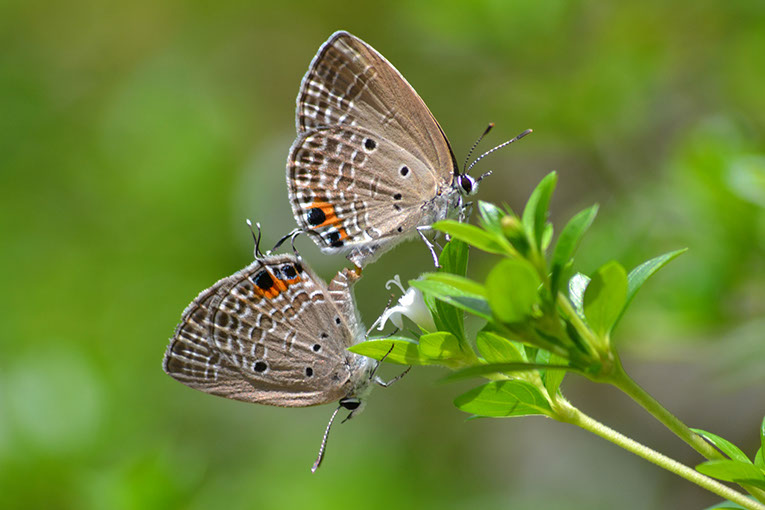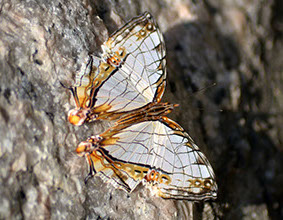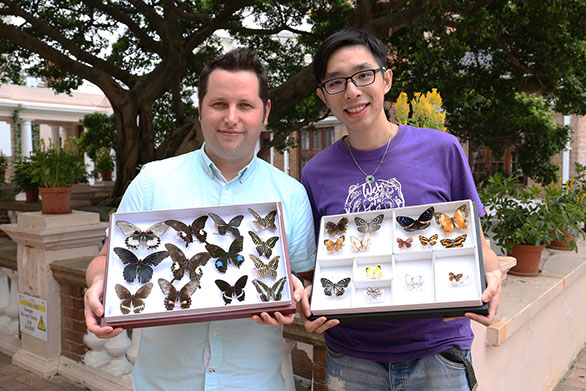
Unveiling The Secret Life of Butterflies
In densely-populated cities public parks provide a much needed green lung for urban
dwellers – and not only the human kind. Insects and butterflies make city parks their home and in recent years the importance of such areas as habitats for greater biodiversity has come to the fore.
PhD student Mr Toby Tsang recently conducted the first urban park butterfly study in Hong Kong, shedding light on the secret life of urban butterflies and providing insight into their management. “Urbanisation is rampant, so their rural habitats are disappearing, but you still see many in urban settings,” he said. “We have to be pragmatic: it’s not just a question of saving the butterflies but saving them in a setting that exists now – urbanisation is not going away, so how can we maximise biodiversity within that setting?”
From April to November, 2014, he walked through the parks of Kowloon – chosen because it is Hong Kong’s most densely populated urban area – counting butterflies. There are more than 250 butterfly species in Hong Kong, of which Mr Tsang found 51 amid the total 1,485 individuals he counted. He noted that some species were common and could be seen almost daily, while others were rare. Of the latter, some were commonly found in more rural areas, while four of them are seldom seen anywhere in Hong Kong, e.g. Jamides alecto, which is classified by the Agriculture, Fisheries and Conservation Department as very rare in Hong Kong.

![]() We have to be pragmatic: it’s not just a question of saving the butterflies but saving them in a setting that exists now – urbanisation is not going away, so how
We have to be pragmatic: it’s not just a question of saving the butterflies but saving them in a setting that exists now – urbanisation is not going away, so how
can we maximise biodiversity within that setting? ![]()
Mr Toby Tsang
Landscape configuration
“We looked at landscape configuration – that is, on a map, draw a one-kilometre circle around the urban park, then analyse how much of that circle is urban and how much green. Some species only do well in one habitat, so if the park is close to a green space they may survive. But rare species tend to die out when disturbance is high, which it tends to be in an urban park with lots of human traffic and regular vegetation management such as pruning and spraying insecticide. They don’t have chance to adapt between disturbances and so are unable to colonise and likely to die.
“Clearly, there is a conflict of interest here – between what humans want from their parks – nicely trimmed plants with a minimum of mosquitoes – and what is best to encourage biodiversity – namely the opposite, a variety of vegetation especially plants that attract butterflies and insects and minimum human traffic.”
One answer to the conflict that Mr Tsang advocates is introducing ‘Nature Corners’ – already in existence in the US and Singapore – where maintenance is minimised and vegetation allowed to grow wild – or, at least, ‘wilder’.
“For Nature Corners to work properly in Hong Kong, we need more empirical knowledge,” he said. “We know that if a park has nectar-providing plants it also has more butterflies, but only common ones. We want to investigate the effect of the disturbance that damages the biodiversity. We also need to do behavioural studies – right now we know what species of butterfly are in our urban parks, next we want to know what they are doing there – to investigate their secret life if you like.”
In the future Mr Tsang would like to compare his results with similar surveys on birds in urban parks. “We want to collect data on other species so we can get a picture of the whole ecosystem.”
Mr Tsang has been supervised in his PhD by Dr Timothy Bonebrake, Assistant Professor at the School of Biological Sciences and Head of the Global Change and Tropical Conservation
Laboratory. Dr Bonebrake noted that: “The most important aspect of Toby’s research is that it puts urban parks in the landscape context, demonstrating that the butterfly species are in the parks because of the green spaces around the parks as much as the parks themselves. It is the broader context that is important – the butterflies commute from the country parks to the urban parks and back again so perhaps we can use urban parks as stepping stones for species to migrate from one place to another.
“Further encouraging butterfly establishment in Hong Kong urban parks will require careful consideration of the surrounding landscape and greater numbers of nectar-providing flowers planted in urban parks.”
Mr Tsang has been studying Ecology at HKU for past seven years. As an undergraduate, his final-year project was a study on rocky shore snails, researching how when the rocks get too warm for them they can still survive. But for his PhD he returned to the terrestrial field and butterflies. Asked about environmental awareness within Hong Kong, Mr Tsang said he thinks young people know about the problems but awareness alone is not enough to prompt them to act. “It’s important to connect with nature,” he said. “If you do not connect, you won’t act, so we need to find ways to get people away from their computers and outside. One way to do that could be to have more biodiversity in our urban parks so people are tempted to go and look.”
Chilades pandava is commonly found in urban parks in Hong Kong.
Cyrestis thyodamas is regarded as rare species in urban parks.
Mr Toby Tsang spent several months walking through the parks of Kowloon and counted 51 species during his surveys, including some very rare species in urban parks.
PhD student Mr Toby Tsang (right) and his PhD supervisor Dr Timothy Bonebrake (left), Assistant Professor at the School of Biological Sciences.





